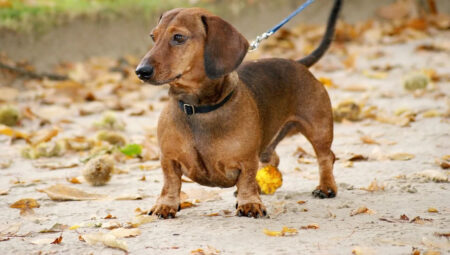Dachshunds, also known as “wiener dogs,” are a popular breed of small dogs characterized by their elongated bodies and short legs. While they may be beloved by many, there are also plenty of reasons why some people may consider them to be the worst breed.
In this article, we will explore the various reasons behind this sentiment and shed light on why Dachshunds may not be the ideal pet for everyone. From their stubbornness and high maintenance needs to their potential health issues and lack of compatibility with children, numerous factors contribute to the belief that Dachshunds are the worst breed. So, before you decide to bring home one of these adorable pups, read on to discover 20 reasons why Dachshunds may not be the best fit for every dog owner.
20 Reasons Why Dachshunds Are the Worst Breed
- Prone-to-back problems
- Difficult to house train
- Stubborn and willful
- Prone to obesity
- Poor with children
- Difficult to groom
- Not great with other pets
- Excessive barking
- Not good for first-time owners
- Prone to separation anxiety
- Health issues
- Can be difficult to train
- Prone to digging
- Strong-willed
- Not good off-leash
- Difficult to find a good breeder
- Not good in extreme weather
- High maintenance
- Prone to aggression
- Difficult to handle
- Prone-to-back problems: Due to their long bodies and short legs, Dachshunds are at a higher risk for back problems such as intervertebral disc disease.
- Difficult to house train: Dachshunds can be notoriously difficult to house trains, leading to accidents and frustration for owners.
- Stubborn and willful: This breed is known for its stubborn streak, making training a challenge.
- Prone to obesity: Dachshunds have a tendency to gain weight if not exercised and fed a proper diet, which can lead to a range of health issues.
- Poor with children: Dachshunds can be aggressive towards children, especially if they are not properly socialized.
- Difficult to groom: Their long, wiry coats require a lot of maintenance to prevent matting and tangling.
- Not great with other pets: Dachshunds have a high prey drive and may not get along with other pets, particularly smaller ones.
- Excessive barking: Dachshunds are known for their loud, persistent barking, which can be annoying for neighbors.
- Not good for first-time owners: Their stubborn and willful nature, along with their high-maintenance grooming needs, make them a challenging breed for first-time dog owners.
- Prone to separation anxiety: Dachshunds are known to become very attached to their owners and may suffer from separation anxiety when left alone.
- Health issues: In addition to their back problems, Dachshunds are also prone to a range of other health issues such as hip dysplasia, eye problems, and epilepsy.
- Can be difficult to train: As a stubborn breed, Dachshunds can be challenging to train, especially if the owner is not consistent and firm.
- Prone to digging: Dachshunds have an instinct to dig, which can be destructive to gardens and yards.
- Strong-willed: Dachshunds are independent and strong-willed, which can make it difficult to control them in certain situations.
- Not good off-leash: Due to their high prey drive, Dachshunds should not be allowed off-leash in unfenced areas, making it difficult to give them proper exercise.
- Difficult to find a good breeder: Due to their popularity, finding a reputable Dachshund breeder can be challenging, leading to potential health and behavior issues in the breed.
- Not good in extreme weather: Because of their short coats, Dachshunds are not well-suited for extreme hot or cold weather.
- High maintenance: Dachshunds require a lot of attention and care, making them a high-maintenance breed.
- Prone to aggression: Dachshunds can be aggressive towards strangers and other dogs, especially if not properly socialized.
- Difficult to handle: Due to their long bodies and small size, Dachshunds can be difficult to handle and may not be suitable for families with small children or elderly individuals.
Are Dachshunds Known for Being Aggressive?
No, Dachshunds are not known for being aggressive. They were originally bred as hunting dogs, but they have also been popular companions and family pets for many years. While all dogs have the potential to be aggressive, proper training and socialization can help prevent any negative behaviors. Dachshunds can have a strong prey drive and may exhibit some protective behaviors, but with proper training and socialization, they can be friendly and well-behaved pets. Owners need to provide proper exercise, mental stimulation, and obedience training for their Dachshunds to prevent any potential aggression.
Are Dachshunds Good for First-time Owners?
Dachshunds can make great pets for first-time owners if they are properly trained and socialized. They are known for their affectionate and devoted nature and are generally good with children and other pets. However, they can also be stubborn and independent, so first-time owners should be prepared to be patient and consistent with their training. Dachshunds also have a high prey drive, so it’s important to properly train them not to chase small animals and to always keep them leashed on walks. Overall, as long as first-time owners are willing to put in the time and effort to properly train and care for a Dachshund, they can make great companions.
Do All Dachshunds Bark A Lot?
While all dogs are different, Dachshunds are known for being vocal dogs that bark quite a bit. They are a breed that is known for being protective, curious, and sometimes stubborn, all of which can lead to barking. That said, not all Dachshunds are overly vocal, and the amount of barking a Dachshund does can be influenced by several factors, including training, socialization, and environment.
Are Dachshunds Hard to Potty Train?
Potty training a Dachshund can be more difficult than potty training other breeds, but it is certainly not impossible. Dachshunds are known for being stubborn and independent, which can make training more challenging. The key to potty training a Dachshund is consistency, patience, and positive reinforcement. It’s important to establish a routine and stick to it, taking your Dachshund outside regularly and rewarding them when they go potty in the right place.
Origin of Dachshund Breeds
The origin of dachshund breeds can be traced back to the 15th century in Germany. They were originally bred for hunting badgers, and their name translates to “badger dog” in German. Dachshunds were developed with short legs, long bodies, and a keen sense of smell to track and hunt badgers in their underground burrows.
It is believed that dachshunds were created by crossing various breeds, including the dachshund precursor, the Bracke, with breeds like the Pinscher and maybe even the Basset Hound. Their unique physical characteristics and hunting abilities made them well-suited for the task of hunting badgers, as they were able to enter and maneuver through narrow burrows.
Dachshunds were first recognized as a breed in the 19th century by the Deutscher Teckelklub (German Dachshund Club). They quickly gained popularity not only in Germany but also in other European countries such as France and England. In the 1880s, dachshunds were introduced to the United States and were first recognized by the American Kennel Club in 1885.
Characteristics of Dachshunds
- Small Size: Dachshunds are a small breed of dog, typically weighing between 11 and 32 pounds and standing at 8 to 9 inches tall at the shoulder. This compact size makes them ideal for apartment living or families with limited space.
- Long Body and Short Legs: One of the defining physical characteristics of Dachshunds is their long, narrow body and short legs. This unique body shape was originally bred for hunting purposes, as it allowed them to easily fit into and navigate through narrow burrows where badgers and other prey animals lived.
- Coat Variety: Dachshunds come in three coat varieties: smooth, wirehaired, and longhaired. The smooth coat is short and shiny, while the wirehaired coat is longer and rougher. The longhaired coat is the softest and silkiest of the three varieties. All coat types come in a variety of colors, including black, red, cream, and dapple.
- Friendly and Energetic: Despite their small size, Dachshunds are known for their friendly and outgoing personalities. They are often described as confident, curious, and playful. Dachshunds also have a lot of energy and love to play and go for walks.
- Independent Nature: Dachshunds have a strong, independent streak and can be stubborn at times. This can make them challenging to train, especially for first-time dog owners. However, with consistent and patient training, Dachshunds can be well-behaved and obedient companions.
- Prone to Health Issues: Like many purebred dogs, Dachshunds are prone to certain health issues, including intervertebral disc disease, back problems, and obesity. Owners need to monitor their Dachshund’s weight and provide them with regular exercise to prevent these health issues.
- Protective and Alert: Dachshunds are a protective breed and will bark to alert their owners of potential danger. This can make them good watchdogs, but it is important for owners to properly socialize their Dachshunds to prevent excessive barking and aggression towards strangers.
- Affectionate and Loyal: Despite their independent nature, Dachshunds are also known for their loving and loyal personalities. They form strong bonds with their owners and love to snuggle and receive attention. Dachshunds make great companions for families and single individuals alike.
Appearance of Dachshunds
Dachshunds are a unique breed with a distinct appearance. They are short-legged, long-bodied dogs that typically stand between 8 and 9 inches tall at the shoulder and weigh between 16 and 32 pounds. Their heads are long and tapered, with big, round eyes and long, floppy ears. Their bodies are short and stocky, with a deep chest and a long, muscular tail. Dachshunds come in three different coat types: smooth, wire-haired, and long-haired. They can be a variety of colors, including black, red, tan, and cream.
Behavioral Challenges of Dachshunds
Although they are often considered to be stubborn, Dachshunds can be quite easy to train if the owner is patient and consistent. However, Dachshunds are known for a few behavioral challenges that can be frustrating for owners. One of the biggest challenges is their tendency to bark excessively. They also tend to be possessive of their food and toys and may growl or snap if they feel threatened. Additionally, Dachshunds have a high prey drive, which means they may chase small animals, like cats and squirrels if they get the chance.
Lifestyle Compatibility of Dachshunds
Dachshunds are a popular breed for good reason – they make great family pets and are well-suited to a variety of lifestyles. They are playful, affectionate, and loyal, making them great companions for adults and children alike. They are small enough to live in an apartment or small home, but they are also active and enjoy plenty of exercise. Dachshunds are relatively low-maintenance when it comes to grooming, but they do require regular brushing to keep their coat healthy and free of tangles.
SEE ALSO: How To Relieve Dog Period Cramps
Cost of Dachshunds
The cost of a Dachshund can vary widely depending on some factors, including the breeder, location, pedigree, and color or coat type. On average, you can expect to pay anywhere from $500 to $2000 or more for a Dachshund puppy.
Health Problems of Dachshunds
- Intervertebral Disc Disease: Dachshunds are prone to intervertebral disc disease, a condition in which the spinal discs become compressed or herniated due to their long backs and short legs. This can cause pain, weakness, and even paralysis in severe cases.
- Obesity: Dachshunds can be prone to obesity, especially if they are overfed or not provided enough exercise. This can put added strain on their joints and increase their risk of other health problems.
- Dental Issues: The long, narrow jaws of Dachshunds can make them more prone to dental problems, such as tooth decay and gum disease. Regular dental care, including brushing their teeth, can help prevent these issues.
- Epilepsy: Dachshunds have an increased risk of developing epilepsy, a neurological disorder that causes seizures. Seizures can range from mild to severe and may require medication to control.
- Eye Problems: Dachshunds have a higher risk of developing eye problems such as cataracts, progressive retinal atrophy, and glaucoma. Regular eye exams can help catch these issues early on and prevent progression.
- Allergies: Dachshunds can be prone to allergies, which can cause skin irritation, itching, and discomfort. Regular bathing and using appropriate flea and tick prevention can help manage and prevent allergies.
- Urinary Tract Problems: Dachshunds, especially males, can be prone to urinary tract problems such as bladder stones and urinary blockages. Keeping them properly hydrated and feeding them a diet appropriate for their breed can help prevent these issues.
- Pancreatitis: Dachshunds may be more susceptible to pancreatitis, an inflammation of the pancreas that can cause vomiting, diarrhea, and other digestive issues. Limiting fatty foods and providing a healthy, balanced diet can help prevent pancreatitis.
- Patellar Luxation: This is a condition in which the kneecap slips out of place, causing pain and lameness in the affected leg. Dachshunds may be more susceptible to this condition due to their long backs and short legs.
- Canine Degenerative Myelopathy: This is a progressive neurological disorder that affects the spinal cord and can lead to paralysis in Dachshunds. While there is no cure for this disease, physical therapy, and other supportive measures can help manage symptoms and improve quality of life.
How to Care for Dachshunds
Here are some tips for caring for your beloved Dachshund:
- Nutrition: Dachshunds are prone to weight gain and obesity, so it is important to regulate their food intake and provide them with a balanced and nutritious diet. Consult with your veterinarian to determine the best type and amount of food for your Dachshund according to their age, size, and activity level.
- Exercise: Despite their short legs, Dachshunds are an active breed that requires regular exercise to maintain their physical and mental well-being. Daily walks and play sessions are essential for keeping your Dachshund healthy and happy. However, be mindful not to overexert them, especially if they are a puppy or have a long back.
- Grooming: Dachshunds have a smooth, short coat that is relatively easy to maintain. Weekly brushing with a soft bristle brush will help distribute their natural oils and keep their coat healthy. They may also benefit from occasional baths, depending on their activity level and coat condition. Pay attention to their ears, which may need cleaning and checking for any signs of infection.
- Dental Care: Dachshunds, like many other small breeds, are prone to dental problems. It is important to establish a regular dental care routine for your Dachshund, including daily teeth brushing and annual dental cleanings by a veterinarian.
- Socialization: Dachshunds are sociable dogs, but they can also be stubborn and territorial. Proper socialization from a young age is crucial for shaping their behavior and making them more comfortable around other people and animals. Exposing them to different people, animals, and environments can help prevent fearfulness or aggression.
- Health Care: Dachshunds are prone to a variety of health issues, including back problems, ear infections, and obesity. Regular check-ups and vaccinations from a veterinarian can help detect and prevent potential health problems.
- Training: While Dachshunds are intelligent and eager to please, they can also be stubborn and independent-minded. Consistent yet gentle training and positive reinforcement methods are recommended to help them learn good behaviors and manners. Enrolling them in obedience classes can also be beneficial.
- Mental Stimulation: Dachshunds are smart and curious dogs that require mental stimulation to prevent boredom and destructive behaviors. Provide them with interactive toys, puzzles, and games to keep their minds active and engaged.
- Safety: Due to their long bodies and short legs, Dachshunds are more susceptible to injuries, especially to their backs. It is important to keep them from jumping on and off furniture, climbing stairs, or engaging in activities that can strain their backs. Consider using pet stairs or ramps to help them navigate around the house safely.
- Love and Affection: Above all, Dachshunds are affectionate and loving pets that thrive on human companionship. Make sure to give them plenty of attention and affection, and they will reward you with endless love and devotion.
SEE ALSO: Will A Dog With Bloat Sleep?
FAQs
Q. What are Dachshunds notorious for?
A. Dachshunds are notorious for a few different things. They are often referred to as “wiener dogs” or “sausage dogs” because of their long, low bodies. They are also known for their stubbornness and intelligence, which can make them difficult to train.
Q. Are Dachshunds stubborn dogs?
A. Yes, Dachshunds are known for being stubborn dogs. They are very intelligent and independent, and they have a strong-willed nature that can make them difficult to train.
Q. Is it true that Dachshunds are high-maintenance dogs?
A. The answer to this question is both yes and no. On one hand, Dachshunds do require a fair amount of care and attention to stay healthy and happy.
Q. Are Dachshunds prone to any specific health issues?
A. Yes, Dachshunds are prone to several health issues that are specific to the breed. The most common health problems seen in Dachshunds include intervertebral disc disease (IVDD), urinary tract infections, skin allergies, and obesity. IVDD is a genetic condition that affects the discs in the spine and can cause the discs to slip out of place, which can result in paralysis.
Conclusion
In conclusion, while dachshunds may be one of the most popular breeds of dogs, some factors contribute to them being considered one of the worst breeds. From their stubborn and independent nature to their potential for health issues, lack of trainability, and tendency for aggression, dachshunds present many challenges for their owners. Additionally, their excessive barking, tendency to dig and chase, and inability to coexist with other animals can make them a difficult breed to accommodate in a household. While some may still find joy in owning a dachshund, potential owners need to be aware of these traits and carefully consider if they are equipped to handle the challenges that come with this breed.


